
Talinum paniculatum, Photo: Michael Lahanas
Classification System: APG IV
Superregnum: Eukaryota
Regnum: Plantae
Cladus: Angiosperms
Cladus: Eudicots
Cladus: Core eudicots
Ordo: Caryophyllales
Familia: Talinaceae
Genus: Talinum
Species: Talinum paniculatum
Name
Talinum paniculatum (Jacq.) Gaertn. De Fructibus et Seminibus Plantarum. 2:219. (1791)
References
USDA, ARS, Germplasm Resources Information Network. Talinum paniculatum in the Germplasm Resources Information Network (GRIN), U.S. Department of Agriculture Agricultural Research Service. Accessed: 28-Oct-07.
Vernacular names
English: Jewels of Opar, Flameflower
Talinum paniculatum is a succulent subshrub in the family Talinaceae that is native to much of North and South America, and the Caribbean countries.[1] It is commonly known as fameflower,[1] Jewels-of-Opar[1] (a name borrowed from the title of the novel Tarzan and the Jewels of Opar by Edgar Rice Burroughs[4]), or pink baby's-breath.[1]
Classification
The species was described in 1760 under the basionym of Portulaca paniculata by Nicolaus Joseph von Jacquin (1727–1817), then recombined in the genus Talinum in 1791 by Joseph Gaertner (1732–1791). In current classification, Talinum paniculatum belongs to the family Talinaceae, it was assigned in the past to the family of the purslane or Portulacaceae.
Appearance
T. paniculatum bears tuberous roots[5] and panicles of flowers and produces tiny, jewel-like fruits. Its peculiarity is its very long root, of orange colour , that reaches about 80 centimeters. It is a very bad herb in crops, and it proliferates very easily, since it roots very easily, even after it has been plucked and if it has any part of the root in contact with the soil. The plant as a whole can reach almost 2 meters high measured from the soil surface, where after maturity, its brown seeds (in abundance), spread easily through the surrounding area.[6]
Native range
Talinum paniculatum is native to the southern United States, much of Latin America (such as Paraguay and Uruguay) and the Caribbean. It has been introduced notably in Africa and Asia.[1]
Uses
Talinum paniculatum is often grown as an ornamental plant. Cultivars include 'Kingwood Gold',[7] 'Limón',[8] and 'Variegatum'.[7] The leaves are edible and have been used in traditional medicine in Asia.[9]
Used in home medicine as a diuretic, healing, emollient, vulval and anti-infective, it is also consumed in salads.[10]
References
Under its current treatment as Talinum paniculatum (from its basionym Portulaca paniculata), this species was published in De Fructibus et Seminibus Plantarum … 2:219. 1791. "Talinum paniculatum". Germplasm Resources Information Network (GRIN). Agricultural Research Service (ARS), United States Department of Agriculture (USDA). Retrieved February 8, 2012.
The basionym of Talinum paniculatum, Portulaca paniculata, was originally described and published in Enumeratio Systematica Plantarum, quas in Insulis Caribaeis vicinaque Americes … 2. 1760. "Portulaca paniculata". Germplasm Resources Information Network (GRIN). Agricultural Research Service (ARS), United States Department of Agriculture (USDA). Retrieved February 8, 2012.
"Talinum dichotomum Ruiz & Pav". The Plant List; Version 1. (published on the internet). Royal Botanic Gardens, Kew and Missouri Botanical Garden. 2010. Retrieved February 8, 2012.
Jewels-of-Opar, Mississippi State University
Sajeva, Maurizio; Mariangela Costanzo (1997). Succulents: the Illustrated Dictionary. Timber Press. p. 219. ISBN 978-0-88192-398-8.
Gaertn., 1791 In: Fruct. Sem. Pl. 2: 219, t. 128, f. 13
Hodgson, Larry (2002). Annuals for Every Purpose. Rodale. p. 303. ISBN 978-0-87596-824-7.
Winter, Norman (2007-06-28). "Limón talinum is jewel for gardens". Southern Gardening. Mississippi State University.
"Philippine Medicinal Plants Godofredo Umali-Stuart". 2010. Retrieved October 30, 2012.
Roskov Y., Kunze T., Orrell T., Abucay L., Paglinawan L., Culham A., Bailly N., Kirk P., Bourgoin T., Baillargeon G., Decock W., De Wever A., Didžiulis V. (ed) (2014). Species 2000 & ITIS Catalogue of Life: 2014 Annual Checklist.. Species 2000: Reading, UK.. Retrieved on 26 May 2014.
Retrieved from "http://en.wikipedia.org/"
All text is available under the terms of the GNU Free Documentation License

